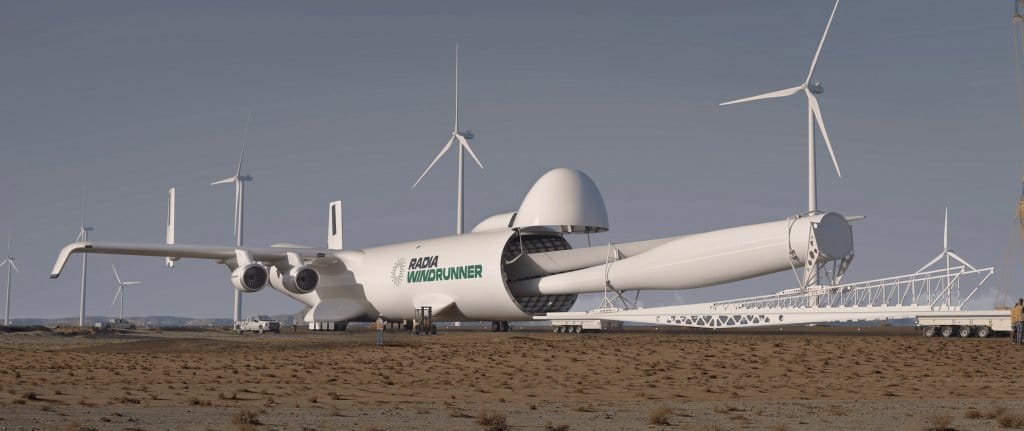Giant WindRunner Cargo Jet Concept Shown Off To USAF
A Colorado company displayed at the Air & Space Force Association’s annual conference this week a model of a new very heavy lift cargo jet it is designing. Though still in its aspirational phase, Radia’s WindRunner concept comes at a time when the future of heavy lift cargo capabilities is in question, including within the U.S. military as it looks to eventually replace its fleet of aging C-5M Galaxy and C-17A Globemaster III transports. Globally, the ability to move very large, outsized loads over long distances by air also has something of an expiration date, without any clear replacement for existing aircraft waiting in the wings. So, while by all accounts Radia’s dream may be a big long shot, it’s certainly worth examining.
The four-engined WindRunner, far bigger in size than either of the two U.S. Air Force airlifters, was originally designed to carry 300-foot-long wind turbine blades. In other words, it originated with the goal of offering a transport solution to commercial customers. However, Radia claims that when it’s built, it could be an attractive airframe for moving tanks, helicopters, collaborative combat aircraft (CCAs) and other large war materiel to austere locations, as well as rocket boosters and other outsized loads.

“As interest grew and development progressed, WindRunner’s unprecedented volume similarly appealed to the defense, aerospace and commercial cargo sectors,” company spokesperson Grace O’Connor told The War Zone.
The C-17A, which first entered service in 1995, has a maximum payload capacity of some 82 tons, according to the official Air Force fact sheet.

The much larger C-5, which has been around since the 1970s, and is now in its enhanced C-5M configuration, can carry up to 140 tons. What’s arguably more important than just the raw weight it can lift, the C-5 can carry far larger items than the C-17.
Capable of being refueled in flight to extend their range, neither this aircraft nor the C-17 is currently in production.

By comparison, Radia states that the 356-foot-long WindRunner, first conceived of in 2016, will be able to deliver 72.6 tons of cargo. However, payload weight only tells a small part of the story, the company suggests.
“Current defense cargo aircraft run out of room before they run out of lift capability,” O’Connor posited. “In other words, military operations cube out on missions before they gross out, making volume the limiting factor. The massive dimensions of today’s military aircraft, modern satellites, missile systems, and mobile hospitals make it challenging to transport mission-ready.“
Instead, many weapons systems have to be disassembled to fit aboard a Galaxy or Globemaster.
Radia claims that WindRunner, with some 270,000 cubic feet of cargo space, delivers seven times the volume of a C-5 and 12 times the volume of a C-17. Among other cargo, Radia says WindRunner can carry six ready-to-fly Chinook C-47 helicopters. The placement of the cockpit in a bulge above the cargo hold offers more vertical space to roll items into its very long hold.

The WindRunner is also claimed to be able to take off and land on 6,000 feet of runway, which is pretty short for such a large plane. One limiting factor, however, may be range. While the C-17 can fly about 2,400 miles with a heavy load without refueling and the C-5 can fly over double that distance with cargo packed in its belly. The WindRunner has a loaded range of just 1,200 miles, according to Radia. So, aerial refueling capability would be a prerequisite for U.S. military service. Still, this may be a worthwhile trade for the ability to easily move very large cargoes while keeping the cheapest aircraft acquisition price possible and tankers already service the C-5M and C-17A fleets heavily for long-distance missions. It may also be possible to extend the giant aircraft’s 261-foot wingspan to increase its range, among other concepts commonly employed to increase an aircraft’s range, such as auxiliary fuel tanks. Radia told us aerial refueling capability would be added for military contracts, but not for the initial tranche of commercial jets
As a scale-model mockup of the WaveRunner was on display on the conference showroom located at the sprawling Gaylord Conference Center at National Harbor, a top Air Force general was in a small meeting room two stories above, talking about the future of the service’s heavy lift.

The U.S. Air Force is still in the early stages of figuring out what it needs for a Next Generation Airlift (NGAL) platform that will replace the C-5s and C-17s. However, the flying branch said it will emphasize greater speed and operational flexibility, as well as the ability to better defend against growing threats when on the ground and in the air.
The commander of AMC, Air Force Gen. John Lamontagne, told reporters, including from The War Zone, that the service currently seeks one aircraft to replace both the Galaxy and Globemaster. Given various budgetary and functional considerations, it is unlikely that a future NGAL would have the same cargo capacity as the Galaxy. You can read more about the tough choices the Air Force faces over its NGAL program in our story here.
Among the NGAL options is an aircraft with a blended wing body, or BWB, configuration. The design could provide increased lifting abilities with large amounts of internal volume, among other advantages. In 2023, the Air Force selected aviation startup JetZero to design and build a full-size demonstrator.

There likely won’t be a replacement aircraft that can match the size of the Galaxy, meaning the Air Force will have to look externally to move its largest cargo. However, there are limited options right now. There are a small number of commercially chartable An-124 Condors, which have roughly similar roll-on, roll-off heavy lift capabilities as the C-5, available today. The existing Soviet-designed Condors won’t last forever. It’s possible that Ukraine could put the Condor back into production in modernized form, but this would be a very large undertaking and it won’t solve the U.S. military’s issue of losing its organic ability to move outsized loads if the single aircraft that will replace the C-17 and C-5 won’t be capable of meeting the latter’s ability to swallow massive cargoes, which seem very unlikely.

It’s worth noting that the world’s largest operational cargo hauling aircraft at the time, the An-225 Mriya, which is an outgrowth of the An-124, was destroyed by Russia at the beginning of its all-out invasion of Ukraine. It served for decades as the heaviest-lifting charter aircraft available, supporting everything from wars to disaster relief operations to moving rail cars and aircraft.

With all this in mind, Radia’s giant cargo hauler could offer the U.S. military a new option to move big loads, if it actually becomes a real aircraft. While this may be more of a niche capability, even if it was offered just on a contracting basis, it would likely be an attractive option for some missions. A militarized version of this aircraft is a far bigger reach, but a small fleet could help fill the gap left by a ‘compromise’ C-5 and C-17 replacement design. The Pentagon has certainly been intrigued with far more exotic heavy lift concepts than this.
Radia claims it is shooting for the first flight of its WindRunner by 2030.
“Radia has raised over $150 million to date and is in discussions to raise additional billions through government support, commercial partnerships, and private capital to complete WindRunner development and production,” O’Connor said when asked how much it will cost to turn the clean sheet design into reality. “Radia has completed concept development and wind tunnel testing and is now preparing for system integration and manufacturing. WindRunner uses largely proven, off-the-shelf systems that are currently certified and flying today. We’ve focused on digital design and analysis, and we are now progressing toward building the full-scale aircraft for certification.”
Radia “has received Letters of Intent (LOIs) from major global customers across wind energy, defense, aerospace, and cargo sectors,” O’Connor added. However, an LOI is not a contract for delivery.
At this point, it is not publicly known where Radia intends to build these jets, if it actually gets the opportunity to do so.
“We are getting closer to publicly announcing our final assembly line location and production capacity,” O’Connor explained.
Radia may not ultimately produce any jets that wear USAF insignias — or any jet at all. However, there appears to be a heavy airlift gap that may form in the coming decades and it may take a mixture of assets, commercial and military, to fill it.
Contact the author: [email protected]








